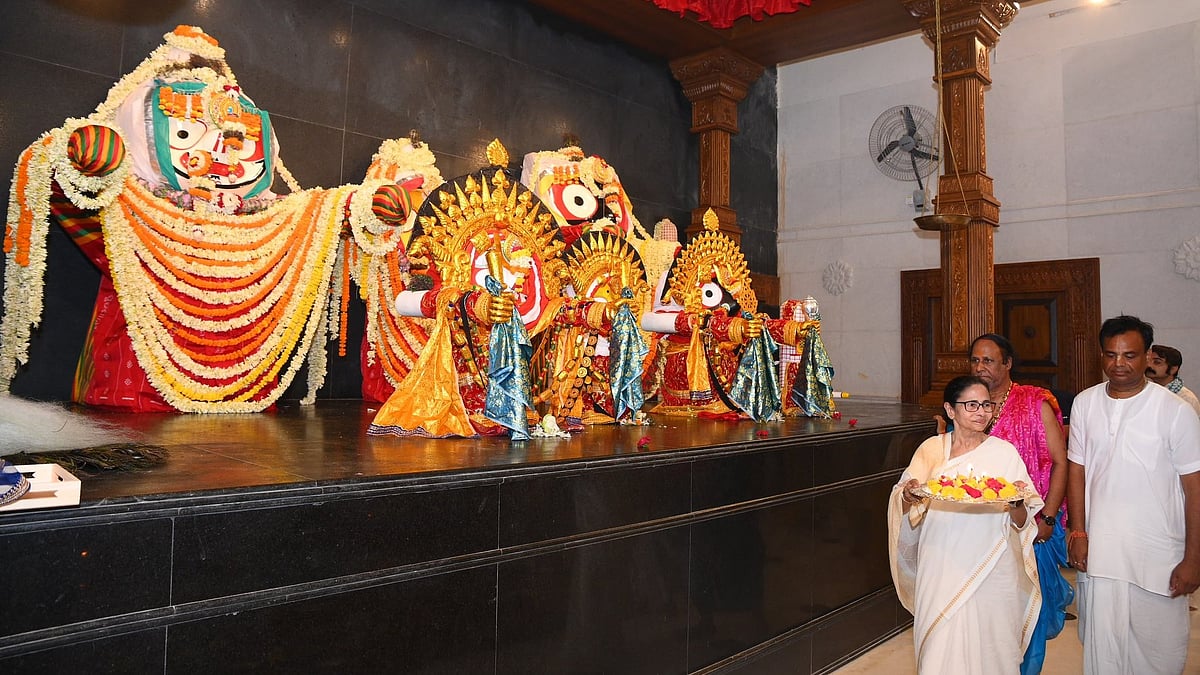The first glimpse of Lord Jagannath enshrined in the Garbhagriha of the Jagannath Temple in Digha. |
Bhubaneswar: On the auspicious occasion of Akshaya Tritiya, West Bengal Chief Minister Mamata Banerjee inaugurated a grand replica of the Jagannath Temple in the seaside town of Digha. Constructed at a cost of ₹250 crore, the 213-foot red sandstone temple—designed in the Kalingan architectural style—mirrors the 12th-century Puri shrine and spans 24 acres.
The consecration ceremony, held on Wednesday, was widely televised across the state on large screens installed by the state government. The event is seen as a strategic outreach to Hindu voters ahead of the 2026 state elections, drawing parallels to the BJP’s Ayodhya Ram Mandir inauguration.
“This is a matter of faith. Religion cannot be imposed through words—it must be felt in the heart,” Banerjee said ahead of the ceremony, in which she actively participated. She emphasized the temple’s architectural splendor and noted the presence of priests and monks from prominent religious institutions including ISKCON and Dakshineswar Kali Temple.
The government has expressed hopes that the temple will elevate Digha—already a popular beach destination—into an international tourist hub. Banerjee described the temple as “the pride of Bengal and India.”
Despite the fanfare, the move has drawn sharp resistance from servitor groups of the original Jagannath Temple in Puri. The Suar Mahasuar Nijog, which prepares offerings (bhog), and the Puspalaka Nijog, which dresses the deities, issued strict warnings to members against participating in any rituals at the Digha temple. Notices were posted around the Puri temple, emphasizing that replicating Puri’s rituals elsewhere could dilute their sanctity.
“We welcome the new temple, but the unique traditions of Puri must be preserved,” said Padmanava Mahasuar, president of the Suar Mahasuar Nijog. The Puspalaka Nijog also condemned promotional slogans suggesting Digha as an alternative to Puri, warning that violators would face disciplinary action.
Announced in 2019, the Digha temple project commenced construction in May 2022 under the supervision of the Housing Infrastructure Development Corporation (HIDCO). It is dedicated to Lord Jagannath, Lord Balabhadra, Goddess Subhadra, and Goddess Mahalaxmi.
Banerjee’s government, which funds numerous temple restoration projects and donates generously to Durga Puja committees, has faced continued criticism from the BJP over alleged minority appeasement—particularly regarding state funding for mosques and madrasas in a state with a 27% Muslim population. The Digha temple initiative is widely viewed as a calculated effort to consolidate Hindu support ahead of a high-stakes election.Bhubaneswar
On the auspicious occasion of Akshaya Tritiya, West Bengal Chief Minister Mamata Banerjee inaugurated a grand replica of the Jagannath Temple in the seaside town of Digha. Constructed at a cost of ₹250 crore, the 213-foot red sandstone temple—designed in the Kalingan architectural style—mirrors the 12th-century Puri shrine and spans 24 acres.
The consecration ceremony, held on Wednesday, was widely televised across the state on large screens installed by the state government. The event is seen as a strategic outreach to Hindu voters ahead of the 2026 state elections, drawing parallels to the BJP’s Ayodhya Ram Mandir inauguration.
“This is a matter of faith. Religion cannot be imposed through words—it must be felt in the heart,” Banerjee said ahead of the ceremony, in which she actively participated. She emphasized the temple’s architectural splendor and noted the presence of priests and monks from prominent religious institutions including ISKCON and Dakshineswar Kali Temple.
The government has expressed hopes that the temple will elevate Digha—already a popular beach destination—into an international tourist hub. Banerjee described the temple as “the pride of Bengal and India.”
Despite the fanfare, the move has drawn sharp resistance from servitor groups of the original Jagannath Temple in Puri. The Suar Mahasuar Nijog, which prepares offerings (bhog), and the Puspalaka Nijog, which dresses the deities, issued strict warnings to members against participating in any rituals at the Digha temple. Notices were posted around the Puri temple, emphasizing that replicating Puri’s rituals elsewhere could dilute their sanctity.
“We welcome the new temple, but the unique traditions of Puri must be preserved,” said Padmanava Mahasuar, president of the Suar Mahasuar Nijog. The Puspalaka Nijog also condemned promotional slogans suggesting Digha as an alternative to Puri, warning that violators would face disciplinary action.
Announced in 2019, the Digha temple project commenced construction in May 2022 under the supervision of the Housing Infrastructure Development Corporation (HIDCO). It is dedicated to Lord Jagannath, Lord Balabhadra, Goddess Subhadra, and Goddess Mahalaxmi.
Banerjee’s government, which funds numerous temple restoration projects and donates generously to Durga Puja committees, has faced continued criticism from the BJP over alleged minority appeasement—particularly regarding state funding for mosques and madrasas in a state with a 27% Muslim population. The Digha temple initiative is widely viewed as a calculated effort to consolidate Hindu support ahead of a high-stakes election.
